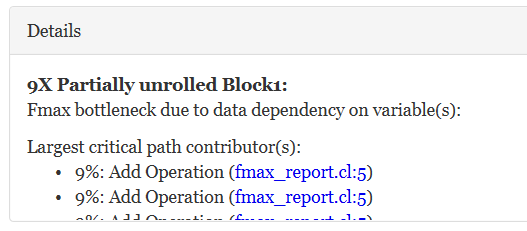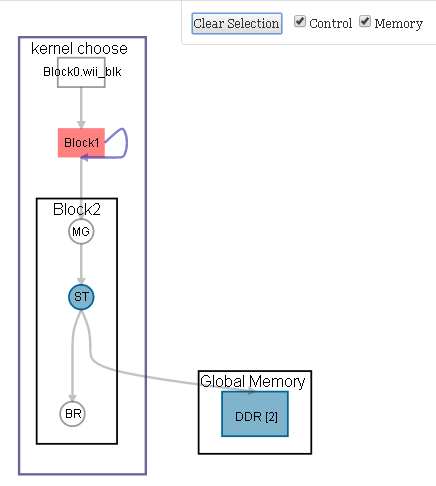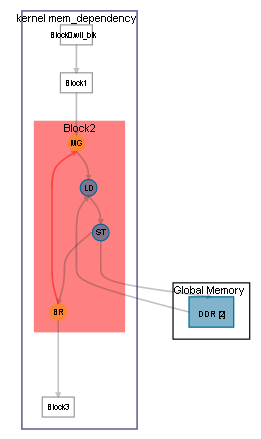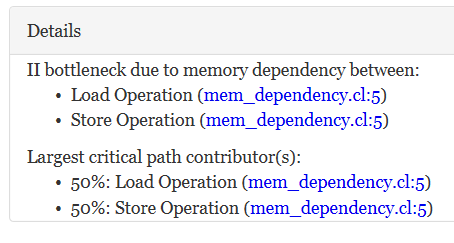Intel® FPGA SDK for OpenCL™ Standard Edition: Best Practices Guide
2.8.5. Loops in a Single Work-Item Kernel
The launch frequency of a new loop iteration is called the initiation interval (II). II refers to the number of hardware clock cycles for which the pipeline must wait before it can process the next loop iteration. An optimally unrolled loop has an II value of 1 because one loop iteration is processed every clock cycle.
In the HTML report, the loop analysis of an optimally unrolled loop will state that the offline compiler has pipelined the loop successfully.
Consider the following example:
kernel void simple_loop (unsigned N,
global unsigned* restrict b,
global unsigned* restrict c,
global unsigned* restrict out)
{
for (unsigned i = 1; i < N; i++) {
c[i] = c[i-1] + b[i];
}
out[0] = c[N-1];
}The figure depicts how the offline compiler leverages parallel execution and loop pipelining to execute simple_loop efficiently. The loop analysis report of this simple_loop kernel will show that for loop "for.body", the Pipelined column will indicate Yes, and the II column will indicate 1.
Trade-Off Between Critical Path and Maximum Frequency
The offline compiler attempts to achieve an II value of 1 for a given loop whenever possible. It some cases, the offline compiler might strive for an II of 1 at the expense of a reduced target fmax.
Consider the following example:
kernel void nd (global int *dst, int N) {
int res = N;
#pragma unroll 9
for (int i = 0; i < N; i++) {
res += 1;
res ^= i;
}
dst[0] = res;
}The following logical diagram is a simplified representation of the actual, more complex hardware implementation of kernel nd.
The feedback with the addition operation and the XOR gate is the critical path that limits the offline compiler's ability to achieve the target frequency. The resulting HTML report describes a breakdown, in percentages, of the contributors that make up the critical path.

Loop-Carried Dependencies that Affect the Initiation Interval of a Loop
There are cases where a loop is pipelined but it does not achieve an II value of 1. These cases are usually caused by data dependencies or memory dependencies within a loop.
Data dependency refers to a situation where a loop iteration uses variables that rely on the previous iteration. In this case, a loop can be pipelined, but its II value will be greater than 1. Consider the following example:
1 // An example that shows data dependency
2 // choose(n, k) = n! / (k! * (n-k)!)
3
4 kernel void choose( unsigned n, unsigned k,
5 global unsigned* restrict result )
6 {
7 unsigned product = 1;
8 unsigned j = 1;
9
10 for( unsigned i = k; i <= n; i++ ) {
11 product *= i;
12 if( j <= n-k ) {
13 product /= j;
14 }
15 j++;
16 }
17
18 *result = product;
19 }For every loop iteration, the value for the product variable in the kernel choose is calculated by multiplying the current value of index i by the value of product from the previous iteration. As a result, a new iteration of the loop cannot launch until the current iteration finishes processing. The figure below shows the logical view of the kernel choose, as it appears in the system viewer.

The loop analysis report for the kernel choose indicates that Block1 has an II value of 13. In addition, the details pane reports that the high II value is caused by a data dependency on product, and the largest contributor to the critical path is the integer division operation on line 13.


Memory dependency refers to a situation where memory access in a loop iteration cannot proceed until memory access from the previous loop iteration is completed. Consider the following example:
1 kernel void mirror_content( unsigned max_i,
2 global int* restrict out)
3 {
4 for (int i = 1; i < max_i; i++) {
5 out[max_i*2-i] = out[i];
6 }
7 }
In the loop analysis for the kernel mirror_content, the details pane identifies the source of the memory dependency and the breakdown, in percentages, of the contributors to the critical path for Block2.
